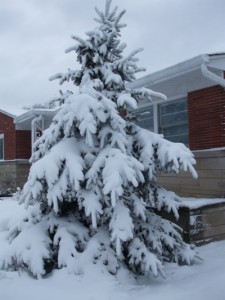It may be tempting to knock the ice and snow off of trees and shrubs, but resist.
It’s ill-advised to try and break the ice or shake the snow from the limb, an action that might cause more damage. However, ice- and snow-laden limbs on trees can be hazardous because the weight may cause them to break.
What to do? The best advise is to let nature do the work and allow the snow and ice to melt naturally. Avoid walking under trees loaded with snow. If a limb does break, your best bet is to call a certified arborist, especially if the limb is large and it tore the bark as it fell.
Multistemmed evergreens, such as yews, arborvitae and junipers, are often damaged, too, by heavy accumulations of snow or ice. The soft, brittle branches of many hardwoods, such as chinese elm, maples, and birch, may be seriously damaged in ice storms. Improper removal of ice or snow from the tree or shrub might increase the damage, according to a Purdue University publication, Winter Injury of Ornamentals.
Evergreens can be protected from snow and ice by tying the branches together with strong rope or twine. If ice accumulates on trees or shrubs, prop the branches up to prevent breakage. Never break ice off trees or shrubs by beating the ice covered branches. This only increases the damage and causes further breakage.
If severe branch breakage occurs because of heavy ice or snow, the branch stubs should be pruned back to the main stem to promote rapid healing and callus formation before growth resumes in the spring.
Other tips:


Excellent advice!
Those limbs do look temping to shake and watch the snow fall… guess that’s not the brightest idea.
i could not help myself either… i would be shaking those babies to. guess it is because there is no snow where i come from.